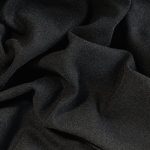Yes, you can make clothes from jute fabric, which offers durability and eco-friendly benefits. While jute is coarse and less stretchy than cotton, innovations are making it softer and more wearable. Its natural breathability keeps you cool, and it’s biodegradable, reducing environmental impact. Although jute requires careful care, it’s perfect for rustic, sustainable fashion styles. If you want to explore how jute clothing supports sustainability and discover future trends, there’s plenty more to uncover.
Table of Contents
Key Takeaways
- Yes, jute can be used to make clothing, offering a coarse, sturdy fabric with a distinctive rustic texture.
- Jute clothing is eco-friendly, biodegradable, and requires minimal water and pesticides for cultivation.
- The fabric’s rough texture and limited elasticity can cause discomfort, so jute is often blended with softer fibers.
- Proper care includes gentle hand washing and flat drying to maintain garment durability and appearance.
- Innovations like enzymatic softening and fabric blending enhance jute’s comfort and style for modern fashion use.
What Is Jute Fabric and How Is It Made?
Jute fabric comes from the fibers of the jute plant, which grows mainly in warm, humid regions.
When you want to understand jute fabric, start by knowing the fibers are extracted through a process called retting, where harvested stalks soak in water to loosen the fibers.
After retting, you separate and dry the fibers, then spin them into threads. These threads are woven into fabric using traditional or modern looms.
You’ll find jute is coarse but strong, making it ideal for sturdy textiles. Although it’s less soft than cotton or silk, jute’s breathability and biodegradability make it an eco-friendly choice.
When you wear or use jute fabric, you’re embracing a natural material created through a simple, sustainable process.
Historical Uses of Jute in Textiles
Although it may seem like a modern fabric, jute has played an essential role in textiles for centuries.
Jute, often mistaken for a modern fabric, has been vital to textiles for centuries.
You’ll find that people have long valued jute for its strength and versatility. Historically, jute has been used in various ways that might surprise you:
- Sacking and Bagging: Farmers and traders relied on jute sacks to store and transport goods like grains and spices.
- Rugs and Mats: Jute’s durability made it perfect for weaving floor coverings that could handle heavy foot traffic.
- Traditional Garments: In some cultures, jute fibers were woven into coarse fabrics for everyday clothing and ceremonial attire.
Advantages of Using Jute for Clothing
When you choose clothing made from jute, you’re opting for a fabric that’s both eco-friendly and durable.
Jute is biodegradable and requires minimal water and pesticides to grow, making it a sustainable option. You’ll appreciate its natural breathability, which keeps you cool and comfortable in warm weather.
Plus, jute’s strength means your clothes will last longer, resisting wear and tear better than many other natural fibers. It also has a unique texture that adds a rustic, earthy charm to your wardrobe.
Additionally, jute absorbs dyes well, giving you access to vibrant, long-lasting colors. By wearing jute, you’re supporting eco-conscious fashion and enjoying a versatile, strong fabric that stands out for both style and sustainability.
Common Challenges When Making Clothes From Jute
Creating clothes from jute poses several unique challenges that can affect both the manufacturing process and the final product. You’ll find jute is coarse and stiff, making it hard to sew and uncomfortable against the skin.
Plus, jute fibers don’t stretch much, which limits design flexibility and fit options. Also, jute tends to absorb moisture easily, causing it to wrinkle or weaken when wet.
When you work with jute, keep these in mind:
- Rough texture can irritate skin unless lined or blended.
- Limited elasticity restricts movement and tailoring.
- High moisture absorption demands careful washing and care.
Innovations in Jute Fabric for Fashion
You’ll find that sustainable treatments are making jute softer and more versatile than ever.
By blending jute with other fabrics, designers create stylish, durable pieces that fit modern tastes.
Plus, new textile techniques are transforming jute into materials you’ll want to wear every day.
Sustainable Jute Treatments
Although jute has long been valued for its natural strength and eco-friendliness, recent innovations in sustainable treatments have transformed its potential in fashion.
You can now enjoy jute fabrics that are softer, more durable, and versatile without compromising their green credentials. These advancements make jute suitable for a wider range of clothing options.
Here are some sustainable jute treatments you’ll find exciting:
- Enzymatic Softening: Uses natural enzymes to break down rough fibers, making jute softer and more comfortable against your skin.
- Natural Dyeing: Employs plant-based dyes, reducing harmful chemicals and water pollution.
- Water-Repellent Coatings: Applies eco-friendly coatings that protect fabric from moisture while maintaining breathability.
These treatments help you embrace jute fashion that’s stylish, practical, and kind to the planet.
Blending Jute With Fabrics
When designers blend jute with other fabrics, they open up new possibilities that enhance both comfort and style. By mixing jute with cotton, silk, or synthetic fibers, they soften its coarse texture and improve durability. This fusion lets you enjoy jute’s eco-friendly benefits without sacrificing wearability. You’ll find these blends in trendy jackets, bags, and casual wear, offering a fresh twist on traditional materials.
| Fabric Blend | Benefits |
|---|---|
| Jute + Cotton | Softer feel, breathable |
| Jute + Silk | Luxurious texture, elegant drape |
| Jute + Synthetic | Increased strength, wrinkle resistance |
These innovative blends make jute a versatile choice for modern fashion you can confidently wear every day.
Modern Jute Textile Techniques
Building on the creative blends of jute with other fabrics, modern textile techniques are pushing jute’s potential even further.
You’ll find that new methods not only enhance jute’s texture but also improve its durability and comfort, making it more suitable for everyday fashion.
Advances like enzyme treatments soften the coarse fibers, while digital printing allows vibrant designs directly on jute fabric. Additionally, combining jute with innovative yarns creates lightweight, breathable textiles perfect for stylish clothing.
Here are some modern techniques transforming jute fashion:
- Enzyme treatment: Softens fibers for a smoother feel
- Digital printing: Adds colorful, detailed patterns
- Hybrid yarns: Mix jute with synthetic fibers for flexibility and strength
Types of Garments Suited for Jute Material
Since jute is a naturally coarse and sturdy fiber, it suits garments that benefit from structure and durability. You’ll find jute ideal for outerwear like jackets and vests, where its strength holds shape well.
It also works great for accessories such as bags, hats, and belts, adding a rustic, eco-friendly touch. While jute isn’t the best choice for soft, close-to-skin items, you can combine it with softer fabrics for skirts or tunics that maintain form but feel comfortable.
Additionally, jute’s breathability makes it suitable for summer wear, especially loose-fitting garments. If you want unique, long-lasting pieces with a natural texture, jute offers plenty of options that balance fashion and function without compromising on durability.
How Jute Clothing Supports Sustainable Fashion
When you choose jute clothing, you’re picking an eco-friendly material that reduces waste thanks to its natural biodegradability.
You’ll also support ethical production practices that prioritize the environment and fair labor.
This makes jute a smart choice for anyone committed to sustainable fashion.
Eco-Friendly Material Benefits
Although many fabrics claim to be sustainable, jute stands out because it requires minimal water and pesticides to grow.
When you choose jute clothing, you’re supporting an eco-friendly material that benefits the planet in several ways.
You’ll love knowing that jute:
- Uses less energy during production compared to synthetic fibers
- Grows quickly, making it a renewable resource you can rely on
- Supports farmers by promoting organic cultivation practices
Biodegradability and Waste Reduction
Because jute naturally breaks down without leaving harmful residues, you can feel confident that your jute clothing won’t contribute to long-term landfill waste.
When you choose jute garments, you’re actively reducing synthetic fabric waste, which often lingers for decades. Jute decomposes quickly, returning nutrients to the soil and supporting a healthier environment.
By wearing jute, you also encourage the fashion industry to shift toward materials that minimize pollution and resource depletion. Plus, jute’s durability means your clothes last longer, cutting down on frequent replacements and textile waste.
When you’re done with your jute pieces, they can be composted or recycled more easily than synthetic options. Opting for jute clothing is a simple yet powerful way to support sustainable fashion and lower your environmental footprint.
Ethical Production Practices
Since jute cultivation relies on minimal chemicals and supports fair labor conditions, choosing jute clothing means you’re backing ethical production practices.
When you opt for jute, you’re directly contributing to a fashion industry that values people and the planet. You help promote transparency and responsibility from farm to fabric.
Here’s how jute clothing supports sustainable fashion:
- Fair Wages and Safe Workplaces: Jute farmers and workers often receive fair pay and work in safer environments compared to conventional textile industries.
- Low Environmental Impact: Growing jute uses less water and chemicals, reducing pollution and conserving resources.
- Community Empowerment: Jute production encourages local economies, helping small farmers and artisans thrive.
Care and Maintenance Tips for Jute Apparel
When you wear jute apparel, you’ll want to handle it with care to keep its natural texture and durability intact.
Avoid machine washing; instead, gently hand wash your jute clothes in cold water using mild detergent. Never wring or twist the fabric, as this can damage its fibers.
After washing, lay your jute garment flat to dry in a shaded area to prevent fading and shrinkage.
Store your jute apparel in a cool, dry place away from direct sunlight to avoid brittleness.
If wrinkles appear, use a low-heat iron with a pressing cloth to protect the fabric.
Finally, keep your jute pieces away from excess moisture and pests by using breathable garment bags or storage containers.
Proper care will extend your jute clothing’s lifespan beautifully.
Future Trends: Jute in the Fashion Industry
Taking good care of your jute apparel not only preserves its quality but also supports the growing demand for sustainable fashion.
As you look ahead, you’ll notice jute gaining traction in the fashion industry due to its eco-friendly nature and versatility. Designers are embracing jute to create innovative, stylish pieces that appeal to environmentally conscious consumers like you.
Expect to see:
- Blended fabrics combining jute with other natural fibers for enhanced comfort and durability
- Bold, textured designs highlighting jute’s unique aesthetic
- Increased use in accessories and footwear, expanding beyond traditional bags and rugs
Frequently Asked Questions
Can Jute Fabric Be Dyed in Vibrant Colors?
Imagine dipping rough, natural fibers into pools of bright, vivid hues. You can dye jute fabric in vibrant colors, but its coarse texture absorbs dyes unevenly, so expect earthy, muted tones rather than glossy, intense shades.
Is Jute Fabric Comfortable for Sensitive Skin?
You might find jute fabric rough and itchy, so it’s not usually comfortable for sensitive skin. However, blending jute with softer fibers can improve comfort, making it more suitable for those with skin sensitivities.
How Does Jute Fabric Compare to Cotton in Breathability?
Breathability is the heart of comfort, and you’ll find jute isn’t as airy as cotton. While cotton lets your skin breathe freely, jute’s coarse fibers trap heat, making cotton the cooler choice for warm days.
Can Jute Clothing Be Machine Washed Safely?
You shouldn’t machine wash jute clothing because it can weaken the fibers and cause shrinkage. Instead, hand wash gently with cold water and mild detergent to keep your jute garments looking fresh and lasting longer.
Are There Any Cultural Restrictions on Wearing Jute Garments?
You might picture jute as rough, but don’t worry—wearing jute garments generally has no cultural restrictions. You can confidently embrace jute fashion without offending traditions or customs in most places worldwide.
- The Manufacturing Process of Nonwoven Polypropylene - July 11, 2025
- Is Suede Considered a Nonwoven Material? - July 11, 2025
- Is Silk a Nonwoven Fabric? - July 11, 2025







